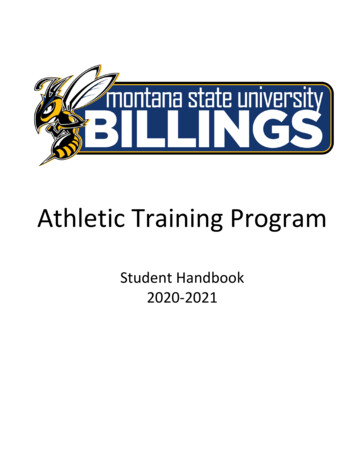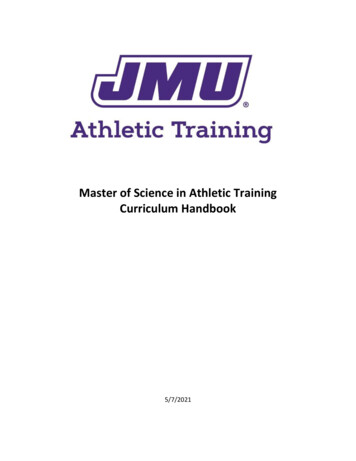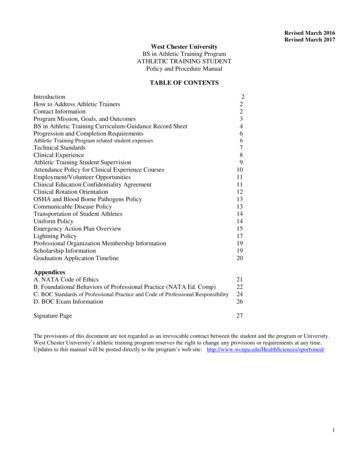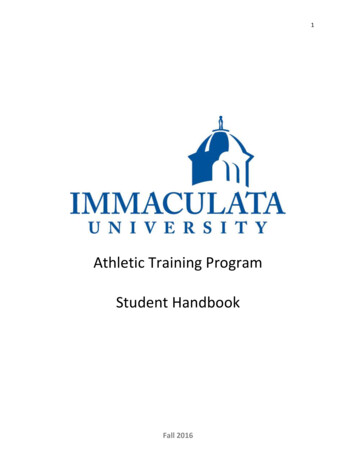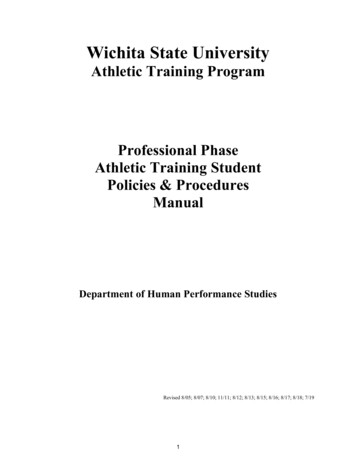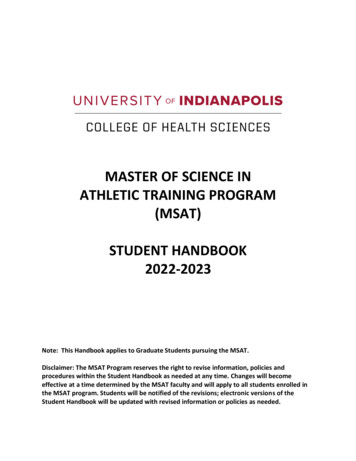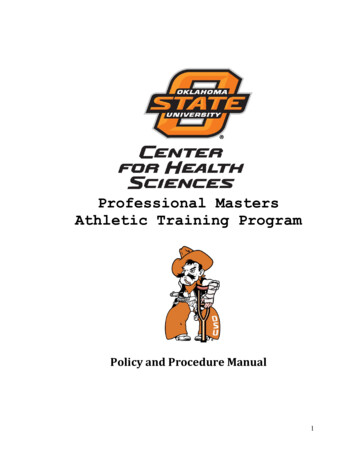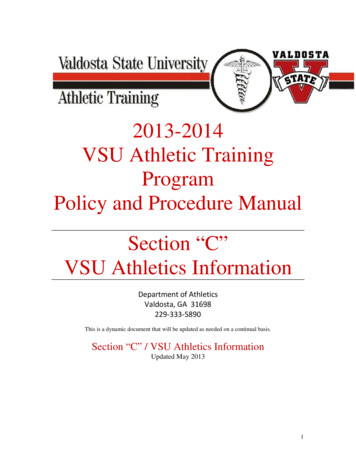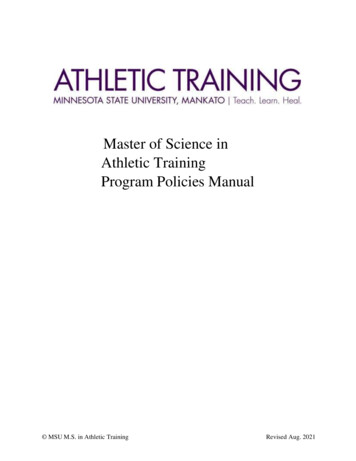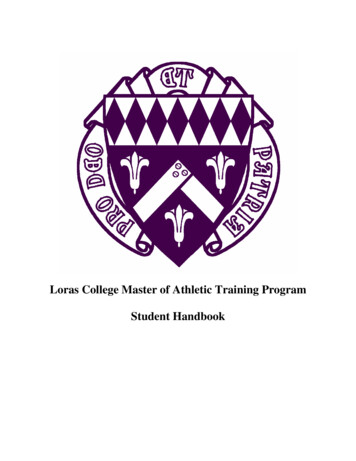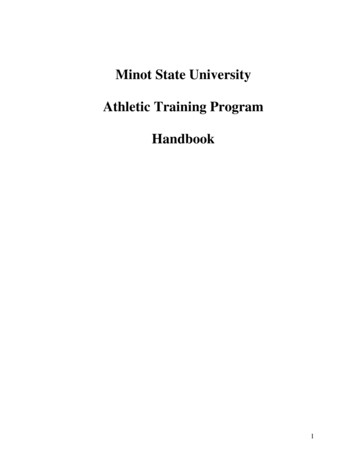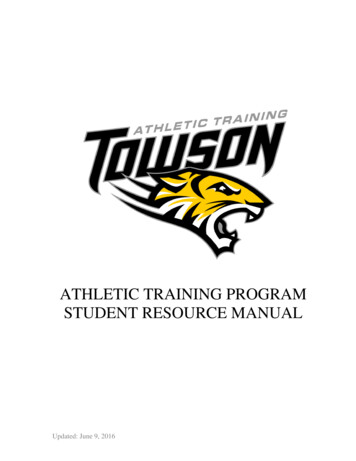
Transcription
ATHLETIC TRAINING PROGRAMSTUDENT RESOURCE MANUALUpdated: June 9, 2016
WELCOMEThe Towson University Athletic Training Program (ATP) would like to take this opportunityto welcome you to our program. As a student in our program we want you to know that youhave put yourself in a very rewarding position that hopefully will assist you in obtaining yourprofessional goals.We are looking forward to having you as a student in our program. We assure you that it isour intent to provide you with a sound academic and professional experience and one thatwill take you wherever you should desire to go. By enrolling in our program, we want you toknow that you have taken on a tremendous amount of responsibility, but it is well worth it!Updated: June 9, 2016
FOREWARDThe Athletic Training Student Resource Manual is designed to maintain an effective andefficient Athletic Training Program (ATP) at Towson University. The contents of thisresource manual are designed to provide quality athletic training education along with safe,prudent and effective care for the student-athletes of Towson University.Furthermore, the Certified Athletic Training Staff will use this resource manual as a guide foradministrative and professional decisions relating to the ATP. It is imperative that AthleticTraining Students of all levels are familiar with the contents of this resource manual. Anyquestions pertaining to the material herein should be directed to a Professor in the ATP or aTowson University Staff Athletic Trainer.ACKNOWLEDGEMENTSpecial thanks go out to all the individuals who had a hand in developing this resourcemanual.Updated: June 9, 2016
TABLE OF CONTENTSSECTION 1 – Introductionoooooo1.1 – Towson University Mission Statement1.2 – ATP Mission Statement1.3 – Athletic Training as a Major1.4 – Description of the Program1.5 – Goals of the Program1.6 – Learning OutcomesSECTION 2 – Athletic Training Program Informationooooooooo2.1 – ATP History2.2 – ATP Faculty2.3 – ATP Admission Process2.4 – ATP Degree Requirements2.5 – Plan of Study2.6 – Athletic Training Education Competencies2.7 – Clinical Practicum Evaluation Procedures2.8 – Advising2.9 – Disciplinary ProceduresSECTION 3 – Responsibilities to Athletic Department and Other Personnelo 3.1 – Team Physicianso 3.2 – Athletic Training Staffo 3.3 – Fellow Athletic Training Students 3.3.1 – Athletic Training Student Hierarchyo 3.4 – Athletic Department Administrationo 3.5 – Coaches / Assistant Coacheso 3.6 – Student-Athleteso 3.7 – Student-Managerso 3.8 – Parentso 3.9 – Visiting Teamso 3.10 – Media / Scouts / FansSECTION 4 - Clinical Experience Expectationso 4.1 – General Information 4.1.1 – Minimum Standards of Qualification 4.1.2 – Contacting your Preceptor 4.1.3 – Types of Experiences 4.1.4 – Locations for Clinical Experiences 4.1.5 – Clinical Hours 4.1.6 – Recording Hours 4.1.7 – Clinical Assignments 4.1.8 – Non Academic Period Expectations 4.1.9 – Travel Expectations 4.1.10 – In-Services 4.1.11 – Grievances 4.1.12 – Criminal Background ChecksUpdated: June 9, 2016
o 4.2 – Appearance and Dress Code 4.2.1 – Unacceptable Attire 4.2.2 – Hair and Grooming 4.2.3 – Jewelry 4.2.4 – Practice Attire 4.2.5 – Game Attire 4.2.6 – Travel Attire 4.2.7 – Inclement / Cold Weathero 4.3 – Personal Conduct Policy 4.3.1 – Class Scheduling 4.3.2 – Outside Employment 4.3.3 – Personal Emergencies / Illness 4.3.4 – Interpersonal Relationships 4.3.5 – Social Media 4.3.6 – Alcohol / Drug Policy 4.3.7 – Punctuality 4.3.8 – Confidentialityo 4.4 – On Campus Facility Expectations 4.4.1 – Athletic Training Room Rules 4.4.2 – Dispensing Over-the-Counter Medications 4.4.3 – Inventory Procedures 4.4.4 – Medical Records Storage 4.4.5 – Computer / Phone Usage 4.4.6 – Daily / Weekly Clean Up 4.4.7 – Modalities 4.4.8 – Rehabilitation Equipment 4.4.9 – Staff Offices 4.4.10 – Personal Belongings 4.4.11 – Staff Locker Room 4.4.12 – Gators 4.4.13 – Setting Up / Breaking Down Practiceso 4.5 – Off Campus Facility Expectationso 4.6 – Documentation Policies 4.6.1 – Injury Record Keeping 4.6.2 – Issuing EquipmentSECTION 5 – Emergency Procedureso 5.1 – Emergency Action Planso 5.2 – Campus Mapo 5.3 – Incident ReportsSECTION 6 – OSHA / Exposure Control / Blood Borne Pathogensoooooo6.1 – Blood Borne Pathogens and Other Potentially Infectious Materials6.2 – Universal Precautions6.3 – Exposure Control Plan6.4 – Procedure for Reporting an Incident6.5 – NCAA Regulation6.6 – OSHA TrainingUpdated: June 9, 2016
o 6.7 – Hepatitis B VaccineAPPENDIX A – Sports Medicine Facility RulesAPPENDIX B – Athletic Training Student Club BylawsAPPENDIX C – Acknowledgment StatementUpdated: June 9, 2016
SECTION 1:IntroductionBack to Table of ContentsUpdated: June 9, 2016
1.1 – Towson University Summary Mission StatementTowson University, as the state’s comprehensive Metropolitan University, offers abroad range of undergraduate and graduate programs in the liberal arts, sciences, artsand applied professional fields that are nationally recognized for quality and value.Towson emphasizes excellence in teaching, scholarship, research and communityengagement responsive to the needs of the region and the state. In addition toeducating students in the specialized knowledge of defined fields, Towson’sacademic programs develop students’ capacities for effective communication, criticalanalysis, and flexible thought, and they cultivate an awareness of both difference andcommonality necessary for multifaceted work environments and for local and globalcitizenship and leadership. Towson’s core values reflect high standards of integrity,collaboration, and service, contributing to the sustainability and enrichment of theculture, society, economy, and environment of the State of Maryland and beyond.1.2 – Athletic Training Program Mission StatementThe mission of the Athletic Training Program is to create, incorporate and applyknowledge of human movement as it relates to athletic training. The ATP program ofstudy is grounded in the University's commitment to liberal arts and sciences.Students are given the opportunity to examine the process and effect of humanmovement from an anatomical, physiological, and biomechanical perspective as wellas a philosophical, psychological, sociological and historical perspective so they candevelop the skills necessary to become certified athletic trainers.In pursuit of its mission, the ATP provides opportunities for its students to have avariety of clinical experiences. These include both on- and off-site intercollegiateclinical experiences as well as public and private secondary schools. Throughparticipation in student practicum and internships, the student is afforded theopportunity to apply their theoretical knowledge of athletic training as it relates toclinical practice.1.3 – Athletic Training as a MajorIn today's health care system, the profession of athletic training is recognized as anallied health profession. In the delivery of health care to athletes, certified athletictrainers are visible in a variety of settings including high schools,colleges/universities, professional sports, sports medicine clinics, wellness centers,corporate industries and hospitals.The Department of Kinesiology offers a program of study in Athletic Trainingdesigned to provide a liberal arts education and develop professional competence.Specifically, the major is intended for students interested in pursuing professionalcertification as an athletic trainer and graduate study.The major of athletic training was developed based on guidelines established by theEducation Council of the National Athletic Trainers' Association. Accordingly, thecore of the major involves instruction in the 8 educational domains. The domains areas follows:Updated: June 9, 2016Back to Table of Contents
1)2)3)4)5)6)7)8)Evidence-Based PracticePrevention and Health PromotionClinical Examination and DiagnosisAcute Care of Injury and IllnessTherapeutic InterventionsPsychosocial Strategies and ReferralHealthcare AdministrationProfessional Development and Responsibility1.4 – Description of the ProgramThe program of study in athletic training is designed for students who are interestedin an allied health care profession specializing in the health care of athletes andphysically active individuals. Athletic trainers function as integral members of theathletic health care team in secondary schools, colleges and universities, sportsmedicine clinics, professional sports programs, and other athletic health care settings.The athletic trainer specializes in the prevention, assessment, management, andrehabilitation of athletic injuries.The Board of Certification (BOC) is responsible for the certification of athletictrainers. In order to attain the ATC credential, an individual must complete an entrylevel athletic training education program accredited by the Commission onAccreditation of Athletic Training Education Programs (CAATE) and pass the BOCcertification examination.The ATP @ TU is designed to provide an effective blend of theoretical and practicallearning experiences in athletic training by incorporating extensive academic andclinical education programs. The ATP is accredited by CAATE and successfulcompletion of the program qualifies the individual as a candidate for the BOCcertification examination.Completion of the academic experience requires 7 regular semesters over a 4-yearperiod. This timeline is due to a variety of reasons, including obtaining prerequisitecourses, sequencing of courses, coordinating academic courses with clinicalexperiences, and the inability to offer athletic training courses during the summersemester. Transfer students are advised that regardless of the number of creditstransferred, it will still take six/seven semesters to complete the program.1.5 – Goals of the Program To provide a student with a quality, well rounded undergraduate educationTo prepare students to become certified Athletic TrainersTo provide all necessary cognitive, psychomotor and affective skills in a formalizedmulti dimensional academic and clinical setting in order to be successful in the fieldof athletic trainingTo have health care professionals be part of the students educational processUpdated: June 9, 2016Back to Table of Contents
To provide all necessary cognitive, psychomotor and clinical skills in a formalizedmulti dimensional academic and clinical setting for successful achievement on theBOC examTo provide opportunities for students to participate in community events andprofessional activities that will instill a sense of active participation in theircommunities and chosen profession after graduationTo provide assistance to each student seeking employment or opportunities to furthertheir education through graduate programs after receiving their Bachelor of Sciencedegree1.6 – Learning OutcomesIt is expected that students in the Athletic Training Education Program will achieveidentifiable learning outcomes subsequent to the successful completion of theprogram.The specific learning outcomes are as follows: Demonstrate professional behaviors, clinical skills, and decision-makingcapabilities that allow for the effective implementation of athletic training care. Apply knowledge of principles, concepts, and theories in the practice of athletictraining Demonstrate skill in conducting an initial assessment of injuries and or illnessescommon to physically active individuals Demonstrate the ability to select, administer, and interpret evaluative tests used in thehealth care of physically active individuals Demonstrate skills in providing appropriate first aid and emergency care for acuteinjuries and sudden illnesses Use assessment data, knowledge, and rehabilitation principles in the formulation ofinjury prevention and rehabilitation programs for musculoskeletal injuries sustainedby physically active individuals Demonstrate skills in analyzing, adapting, and applying therapeutic exercises,therapeutic modalities, and pharmacological agents in injury prevention andrehabilitation programs for physically active individuals Use effective verbal and non-verbal communication skills in working with physicallyactive individuals and sports medicine team personnel in providing athletic trainingcare Promote athletic training in accordance with guidelines identified in the NATA codeof ethics Document information pertaining to athletic training care using appropriate writtenexpression Use knowledge of health care systems, organizations, and management principles tofunction effectively in the role of an athletic trainerUpdated: June 9, 2016Back to Table of Contents
SECTION 2:Athletic Training Program InformationThis section will provide information regarding the ATP at Towson University and affiliatingsites. It will include information on the history of the Athletic Training Program at TowsonUniversity as well as information for prospective and current students within the AthleticTraining Program.Back to Table of ContentsUpdated: June 9, 2016
2.1 – ATP HistoryAthletic training education historically has been one of the core academic programswithin the Department of Kinesiology at Towson University. Initially introduced in1979, the Athletic Training Education Program provided interested students with abasic academic foundation complemented with extensive clinical experiences. Thesestudents were eligible for the certification examination based on the publishedguidelines of the National Athletic Trainers' Association (NATA). Student, staff andfaculty interest in the program resulted in the on-going development of thisprofessional education program.During the 1986-87 academic year, based on guidelines established by theProfessional Education Committee of the NATA, an evaluation of the program ofstudy in athletic training was conducted. This was done in an effort to ensure that theprogram was meeting educational standards and the needs of those it intended toserve. The findings from that assessment resulted in further development of theprogram to a level which the university considered deserving of recognition as aNATA Approved Undergraduate Athletic Training Education Program.In October 1990, the Athletic Training Education Program was submitted to theProfessional Education Committee of the NATA for review. In June 1993, followingthere initial and follow up assessments, the NATA approved the Athletic TrainingEducation Program at Towson University. While receiving status, as an approvedprogram was a significant step, it has proven to be just the beginning. In January1997, the Athletic Training Education Program was elevated from a concentration toan academic major. In August 1997, Towson University submitted a self-study reportto the Joint Review Committee on Athletic Training Education Programs. Followingthe initial assessment and site visitation, the Athletic Training Education Program atTowson University was granted accreditation and by the Commission onAccreditation of Allied Health Education Programs (CAAHEP). Following anotherself-study and site visit in 2004-05 the ATP received continuing accreditation fromCAAHEP. In the spring of 2008, the ATP received a 10-year accreditation from theCommission on Accreditation of Athletic Training.The program continues to evolve and develop. Based on the university's historicliberal arts mission, this professional program integrates the liberal arts generaleducation core with a strong scientific foundation. The essential athletic training corecourses are further complemented by strong elective options. Finally, studentscomplete an extensive clinical experience in the athletic training setting to furthercomplement and reinforce the didactic lessons. The Athletic Training Program atTowson University is designed to prepare students for BOC certification and a careeras an athletic trainer.Updated: June 9, 2016Back to Table of Contents
2.2 – ATP FacultyA listing of the current ATP faculty can be found by following this f.asp (To access the link, hold theCTRL key and click on the link.)2.3 – ATP Admission ProcessThe application, description of the admission process and technical standards rospectivestudents/index.asp(To access the link, hold the CTRL key and click on the link.) If updates to theapplication process are made, they will be presented in KNES 291.2.4 – ATP Degree RequirementsYou are expected to familiarize yourself with the Undergraduate Catalog and tosatisfy all published degree requirements. Failure to do so does not provide a basis forexceptions to academic requirements or policies. You will receive assistance fromgeneral academic and faculty advisors, but it is your responsibility for completingpublished degree requirements. You are also expected to be familiar with regulationspertaining to campus life and to conduct yourself in a way that reflects well uponyourself, the Athletic Training Program, and Towson University. Finally, you areexpected to maintain communication with the university and to ensure that yourcurrent addresses and telephone numbers are on file with Enrolment Services and theAthletic Training Program.By fulfilling the following requirements you will be eligible to graduate with aBachelor of Science Degree in Athletic Training: Completion of a graduation application filed with the Graduation Office(http://grad.towson.edu/graduation/apply.asp in the Enrollment Services Centerby their posted deadline A minimum of 120 earned credit Competition of the Core Curriculum Requirements- The purposes of the core curriculum requirements are designed to provideyou with a liberal arts education. In a world of rapid economic, social, andtechnological change, the importance of a broadly based educationbecomes more apparent. Your higher education must serve as a greaterfunction then to merely provide basic training for the field of AthleticTraining. Your entire education must help you gain essential intellectualskills that are crucial throughout your life.- These requirements are grouped into two basic categories: Skills for Liberal Learning Contexts for Liberal Learning- Please refer to your appropriate University Undergraduate Catalog foryour specific requirements http://www.towson.edu/registrar/degree/ At least 32 credit hours of upper level course work (300/400 level classes)Updated: June 9, 2016Back to Table of Contents
Completion of Writing for a Liberal Education (ENGL102) or its equivalent witha grade equivalent of 2.75 or higherCompletion of the athletic training major (grade equivalent of 2.75 or higher mustbe earned in all courses applied toward your major and applicable aining/degreerequirements.aspA cumulative quality point average of at least a 2.75 per semester2.5 – Plan of StudyA listing of the required Athletic Training Courses can be found in the following etictraining/currentstudents/index.aspTo access the link, hold the CTRL key and click on the link. Please refer to theAcademic Catalog, your academic advisor or the ATP Program Director if you havequestions regarding a specific course.2.6 – Athletic Training CompetenciesThe basis of the ATP is the Athletic Training Education Competencies (5th edition)http://www.nata.org/education/competencies as set for by the NATA. You will berequired to learn these competencies during your course of study. You will beinstructed and evaluated in these competencies in the classroom and clinical settings.You will have many opportunities to practice and be evaluated in the competenciesthroughout your academic careers. You must demonstrate competency in allcompetencies prior to graduation.2.7 – Clinical Practicum Evaluation ProceduresThe Athletic Training Student will be evaluated twice during each academic semester.For each rotation you are required to have a preceptor complete an evaluation on yourknowledge of the required proficiencies. This evaluation is a tool used to assess yourability to clinically perform skills learned in the classroom. Give your preceptorsufficient time (7-10 days dependant on travel schedule) to complete the evaluation.Once the evaluation is completed both the student and preceptor will sit and discussthe evaluation and electronically sign it on ATrack. Your ability to complete theassigned clinical proficiencies and your evaluation on said proficiencies will impactyour evaluation grade. The evaluation grade is a significant percentage of yourclinical course grade. If there is a violation of HIPAA or the student acts in a mannerdeemed unprofessional, grade reduction will occur and/or failure of the rotation mayoccur.The Athletic Training Student is expected to complete two (midterm and final)evaluations of each of their Preceptors. You are expected to review all evaluationswith your preceptor, with both parties signing the evaluations after the review. Inaddition to the student and preceptor evaluations, the student is required to completean evaluation of the clinical site.Updated: June 9, 2016
Your completed evaluation needs to be returned to the Clinical EducationCoordinator (CEC) or professor responsible for your clinical course. Theseevaluations are part of the practicum grade. Failure to return these evaluations willaffect the clinical in athletic training course grade negatively. All evaluation formsare found on and are to be completed directly on ATRACK(https://www.atrackonline.com/).2.8 - AdvisingYou will be assigned an advisor who will assist you in selecting and scheduling youracademic coursework. Contact your advisor or the program director to make sure youare on schedule to graduate at the appropriate time.2.9 – Disciplinary ProceduresThe ATP requires that all students maintain a 2.75 overall GPA and a 2.75 AT courseGPA. You will be placed on probation if: Your GPA falls below a 2.75 You receive a grade lower than a C in any ATP required class You receive two failing grades during the same semester You receive an unsatisfactory grade in a clinical classDuring the probationary period you must continue to attend class and rectify thereason for your probation. During your probationary period an adjustment to yourclinical hours may occur and will be at the discretion of the Program Director. If youare unable to rectify the situation in the allotted time, you will be suspended from theATP for 1 year. If the problem continues in your next academic year, you will bedismissed from the ATP. If you retake a course and receive a failing grade for asecond time, you will be dismissed from the program. If you are able to comply andcorrect all things during your probationary period, the probation will be lifted. Youwill not be placed on probation for a second time for the same problem instead youwill be dismissed from the program. Regardless of the reason you will never beplaced on probation for a third time, you will be dismissed from the ATP.Updated: June 9, 2016
SECTION 3:Responsibilities to Athletic Departmentand Other PersonnelAs an Athletic Training Student, you will have the opportunity to interact with manydifferent people during your clinical experience. The following pages outline some of theresponsibilities you may have to these individuals.Updated: June 9, 2016Back to Table of Contents
3.1 – Team PhysiciansRelationships between the Athletic Training Student and the physician can elicitvaluable learning experiences. Much can be learned by watching and listening to thephysicians. Athletic Training Students should assist the physician in helpful ways,but should not interfere with the physician’s duties.Responsibilities to the Physicians: Keep all injury and medical reports up to date and legible Carry out all physicians recommendations Consult the Certified Athletic Training Staff before referring a student-athlete tothe Team Physician3.2 – Athletic Training StaffThe entire Athletic Training Staff (Head, Associate, Senior, Assistant, and Intern)works with the Team Physician and consulting physicians in providing medical careto those participating in intercollegiate athletics at Towson University. It is also theresponsibility of the Staff Athletic Trainer to coordinate, instruct, supervise, andevaluate the Athletic Training Students in their daily duties. The Athletic TrainingStudent is required to fulfill and follow each of the duties and responsibilities outlinedby the Staff Athletic Trainers. The ATS must maintain lines of communication andshould feel free to discuss problems or difficult situations with the Staff AT at anytime.Responsibilities of the ATS to the Athletic Training Staff: Keep each member of the Athletic Training Staff informed of the injury andrehabilitation status of all student-athletes Assist in routine duties and procedures as designated by the Athletic TrainingStaff Notify the Athletic Training Staff, in writing, of any problems or concernsrelating to Athletic Training Student duties, event coverage or equipment3.3 – Fellow Athletic Training StudentsIt is important for all Athletic Training Students to develop an awareness of theirposition within the Athletic Training Staff. It is imperative for the success of the staffthat all Athletic Training Students work together toward a common goal – the healthcare of the student-athlete. You are a representative of the ATP, Towson University,the Athletic Department, each respective athletic team and the profession of athletictraining. You will demonstrate leadership for each other, while maintainingprofessionalism.You may wish to socialize together when not in the athletic training room, howeveroutside activities should never be brought into the athletic training room. Every ATSwill be treated fairly. Should problems (lack of cooperation, personality conflicts,etc) develop between students, you are expected to manage the situation with allinvolved parties on your own first. If this is unsuccessful, you should seek the adviceand assistance of a certified staff member.Updated: June 9, 2016Back to Table of Contents
Working as an athletic trainer is a “people business” that will require the developmentof the ability to get along with other people. With a sizable group, there will beproblems; confront them, solve them, and move forward with your life in athletictraining and enjoy your work.Responsibilities to fellow Athletic Training Students: Assist other Athletic Training Students (regardless of assignment) wheneverpossible Treat all Athletic Training Students with respect regardless of their classstanding or skill level Become familiar with and understand all aspects of the Athletic TrainingEducation Program Student Resource Manual.3.3.1 – Athletic Training Student Hierarchy1st year Athletic Training Students – observational period used as an orientationand evaluation process for potential members of the Athletic Training Education.2nd year Athletic Training Students – assist upper class Athletic Training Studentsand the certified staff with daily athletic training duties, apply appropriate athletictraining related skills in the practical setting, and act as a role model for 1st yearcandidates3rd year Athletic Training Students – assist the certified staff with daily athletictraining duties, apply appropriate athletic training skills in a practical setting, lead byexample and motivate peers to succeed in the ATP.4th year Athletic Training Students – assist the certified staff with daily athletictraining duties, apply appropriate athletic training skills in a practical setting, lead byexample and motivate peers to succeed in the ATP, serve as a mentor for athletictraining students.3.4 – Athletic Department AdministrationThe Athletic Department is the governing body of all athletics and athletic supportgroups at Towson University. Due to the service that the Athletic Training Staffprovides to the University, the policies and procedures of the Athletic Departmentinclude athletic training. All Athletic Training Students should become familiar withthe policies and procedures, which involve the Sports Medicine Facilities and Staff.Responsibilities to the Department: Be knowledgeable of all athletic staff and their function within the department Be knowledgeable of the facilities and locations of athletic department offices Be knowledgeable of the chain of command within the department3.5 – Coaches / Assistant CoachesThe job of the coaches is to instruct their players in the skills, strategies, andtechniques of their particular sport. It is important that the Athletic Training Studentdoes not become involved in the duties of the coach. This includes polite and/orappropriate cheering for your team on the sidelines during games. Unhappiness withUpdated: June 9, 2016Back to Table of Contents
officiating, players, opposing players is left to the discretion of the coach and shouldat no time be verbalized by an ATS on the sidelines of a game, you must remainprofession in the “heat” of the game.The assistant coaches should be treated andrespected in the same manner as the head coaches. At the same time, Head andAssistant Coaches should not act in a disrespectful way towards Athletic TrainingStudents (including decisions regarding activity status of the student-athletes). If aproblem arises, it should be brought to the attention of a Certified Athletic Trainerimmediately.Responsibilities to the Coaches: Communicate with the coaches at the appropriate times Inform the coaching staff of any adverse weather conditions (including slingpsychrometer readings) and make appropriate recommendations regardingthose weather conditions in conjunction with a member of the CertifiedAthletic Training Staff. Adhere to the rules set by the coaching staff for
The Athletic Training Student Resource Manual is designed to maintain an effective and efficient Athletic Training Program (ATP) at Towson University. The contents of this resource manual are designed to provide quality athletic training education along with safe, prudent and effective care for the student-athletes of Towson University.
